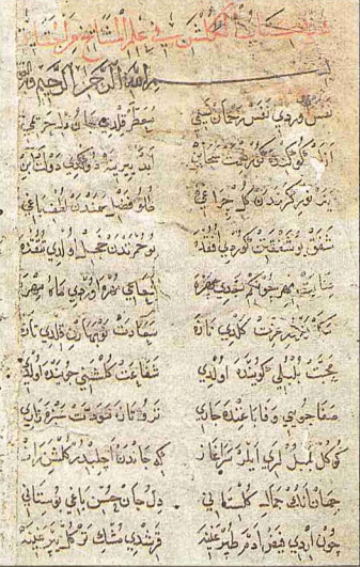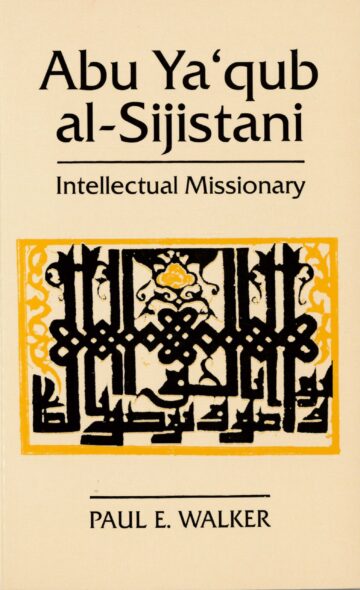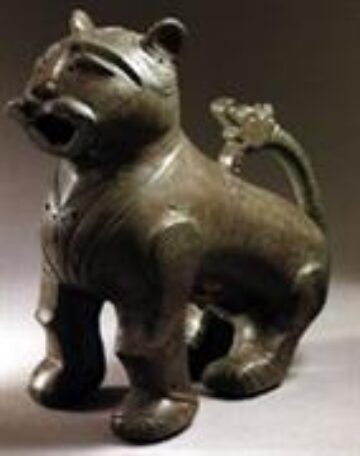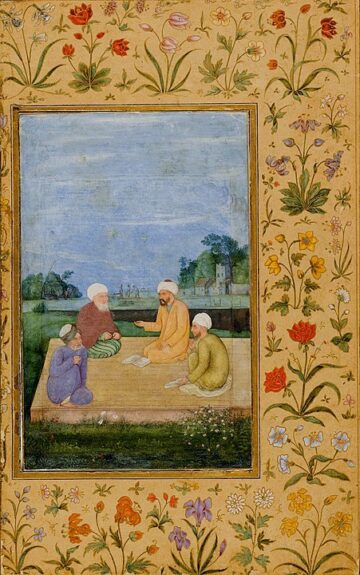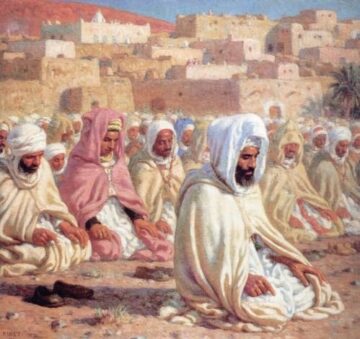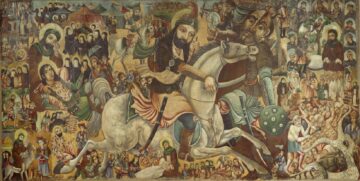Abstract
A fortress on the summit of an isolated rocky hill in the Alburz mountains, situated some 18km west of Damgan in northern Persia.
Thrust forward into a sloping plain, the hill of Gerdkuh rises about 300 metres above its base, and seen from the south, the access direction to the site, the hill appears dome-shaped; hence its name Gerdkuh (round mountain). In medieval times, Gerdkuh was also known as Dez-i Gonbadan which Islamic sources identified with the one mentioned in the “Shahnama” (ed. Vullers, III, pp. 1550, 1552, 1635, 1643, 1671;’Mujmal, p. 52; Rashid al-Din, 1959, p. 117; Mustawfi,’Nuzhat al-qulub, text p. 161, tr. P. 158; idem,’Tarikh-i guzida, p. 93).
Location and description
A fortress on the summit of an isolated rocky hill in the Alburz mountains, situated some 18km west of Damgan in northern Persia. Thrust forward into a sloping plain, the hill of Gerdkuh rises about 300 metres above its base, and seen from the south, the access direction to the site, the hill appears dome-shaped; hence its name Gerdkuh (round mountain). In medieval times, Gerdkuh was also known as Dez-i Gonbadan which Islamic sources identified with the one mentioned in the Shahnama (ed. Vullers, III, pp. 1550, 1552, 1635, 1643, 1671; Mujmal, p. 52; Rashid al-Din, 1959, p. 117; Mustawfi, Nuzhat al-qulub, text p. 161, tr. P. 158; idem, Tarikh-i guzida, p. 93).
Gerdkuh in history
The date and circumstances of the construction of Gerdkuh, possibly a pre-Islamic site, remain unknown. The earliest known reference to Gerdkuh dates back to the early 4th/10th century in connection with the early Ismaili movement in the JibalNorthwest and west-central Persia.. According to this, it was the residence of the Ismaili da‘i ‘Abd al-Malik Kawkabi, one of the immediate successors of the da‘i Abu Hatim Razi (d. 322/934; Nizam al-Mulk, p. 287; Rashid al-Din, 1959, p. 12). Later in the 5th/11th century, the fortress came into the possession of the local Saljuk amirs in Damgan (Ibn al-Athir, Beirut, X, p. 38). From the end of the 5th/11th century until the middle of the 7th/13th century, the history of Gerdkuh is closely connected with the history of the Nizari Ismaili state of Persia during the Alamut period (Daftary, pp. 343-44, 363, 365, 367, 381, 414, 421-22, 425, 428-29).
Gerdkuh and the Nizari Ismailis
Gerdkuh was placed at the disposal of Hasan Sabbah, the founder of the Nizari Ismaili movement in Persia, by Ra’is Mu’ayyad al-Din Muzaffar b. Ahmad Mustawfi, around the year 493/1100. Ra’is Muzaffar, a secret Ismaili convert in the service of the Saljuks, had earlier persuaded his superior Saljuk amir, Amirdad Habashi, to acquire Gerdkuh from Sultan Barkiaruq granted the request in 489/1096 and Habashi appointed Ra’is Muzaffar as his lieutenant there, Ra’is Muzaffar, still posing as a loyal Saljuk officer, reconstructed Gerdkuh, making it as self-sufficient and impregnable as possible (Juwayni, ed. Qazvini, III, pp. 207-8, tr. Boyle, II, pp. 678-79; Rashid al-Din, 1959, pp. 116-20; Kashani, pp. 151- 55). It was a strongly fortified castle with ample water and food storage facilities, capable of withstanding long sieges, when it came into the possession of the Nizari IsmailisAdherents of a branch of Shi’i Islam that considers Ismail, the eldest son of the Shi’i Imam Jaʿfar al-Ṣādiq (d. 765), as his successor.. Ra’is Muzaffar served as the Nizari commandant of Gerdkuh for a long time and was succeeded by his son Sharaf al-Din Muhammad.
Situated strategically along the Khurasan road, and guarding the eastern approaches to the Alburz mountains and the Caspian highlands, Gerdkuh served as the most important Nizari stronghold in Qumis, one of the main scattered territories of the Nizari state in Persia. At various times, the Nizaris also levied rolls on travellers passing Gerdkuh (Juvayni, ed. Qazvini, III, pp. 213-14, tr. Boyle, II, pp. 681-82; Rashid al-Din, 1959, p. 123; Kashani, p. 144). Gerdkuh became the last Nizari stronghold in Persia to surrender to the Mongols. The fortress was besieged for 17 consecutive years, starting in Rabi‘ I 651/May 1253. The garrison of Gerdkuh finally surrendered for the want of clothing in Rabi‘ II 669/December 1270, some 13 years after the fall of AlamutFortress of the Nizari Ismailis in northern Iran, which fell to the Mongols in 654 AH/1256 CE.. The Mongols did not demolish Gerdkuh, as in the case of some other major Nizari fortresses in Persia (Rashid al-Din, Tarikh-i ghazani, 1940, pp. 30, 56; idem, Tarikh-i ghazani, 1941, p. 29; idem, Jami‘ al-tawarikh, Baku, III, pp. 35-36, 140, 2727, 286-87; Juzjani, II, p. 186). Gerdkuh was still in use in 786/1384 (Yazdi, I, pp. 280-82), but there is no mention of it in later sources. It seems to have been completely abandoned by the time of the early Safavids. The ruins of the living quarters built by the besieging Mongols and the two different types of the mangonel stones, used by the Nizaris and the Mongols, are still scattered on the northeastern slope of the hill (visited by the present writer in 1985).
The fortress today
Of the major Nizari fortresses in Persia, Gerdkuh is the one least studied in modern times. No archaeological survey has been made of the extensive ruins and fortifications which exist on the summit and along the sides of the hill, and of the three outer walls of the site. I‘timad al-Sultana, who visited Gerdkuh in 1300/1882-83, has left a brief description of its ruins (III, p. 302-7).
Author

Dr Farhad Daftary
Co-Director and Head of the Department of Academic Research and Publications
An authority in Shi’i studies, with special reference to its Ismaili tradition, Dr. Daftary has published and lectured widely in these fields of Islamic studies. In 2011 a Festschrift entitled Fortresses of the Intellect was produced to honour Dr. Daftary by a number of his colleagues and peers.
Bibliography
Muhammad-Hasan Khan I‘timad al-Sultana, Matla‘ al-shams, Tehran, 1301-3/1883-86. F. Daftary, The Isma‘ilis: Their History and Doctrines. Cambridge, 1990. Firdawsi, Shahnama, III, ed. J. A. Vullers, Leiden, 1884.
G. S. Hodgson, The Order of Assassins, The Hague, 1955.
Hamd-Allah Mustawfi, Tarikh-i guzida, ed. ‘A.-H Nava’i, Tehran, 1339 S./1960. W. Ivanow, ‘Some Ismaili Strongholds in Persia,’ Islamic Culture 12, 1938, pp. 392-96.
Abu’l-Qasim ‘Abdallah Kashani, Zubdat al-tawarikh. Tarikh-i Isma‘iliya, ed. M.-T. Daneshpajuh, 2nd ed., Tehran, 1366 S./1987.
Nizam al-Mulk, Siar al-muluk (Siasatnama), ed. H. Darke, 2nd ed., Tehran, 1347 S./1968.
Rashid al-Din Fadlallah, Jami‘ al-tawarikh: Qismat-i Isma‘ilian, ed. M.-T. Daneshpajuh and M. Mudarresi Zanjani, Tehran, 1338 S./1959.
Idem, Tarikh-i mubarak-i gazani, ed. K. Jahn, London, 1940.
Idem, Tarikh-i mubarak-i gazani. Dar dastan-i Abagha Khan, ed. KI. Jahn, Prague, 1941. M. Sotuda, Qila‘-i Isma‘iliya, Tehran, 1345 S./1966, pp. 142-60.
Yaqut, Boldan, s.v. ‘Damgan.’
Sharaf al-Din ‘Ali Yazdi, Zafarnama, ed. M. ‘Abbasi, 2 vols, Tehran, 1336 S./1957.
This article was originally published in Encyclopaedia Iranica, Vol. X, p. 499, ed. Ehsan Yarshater, New York, 2001.
The use of materials published on the Institute of Ismaili Studies website indicates an acceptance of the Institute of Ismaili Studies’ Conditions of Use. Each copy of the article must contain the same copyright notice that appears on the screen or printed by each transmission. For all published work, it is best to assume you should ask both the original authors and the publishers for permission to (re)use information and always credit the authors and source of the information.
© 2001 Encyclopaedia Iranica
© 2003 The Institute of Ismaili Studies
Cover image: Mongolian siege of Gerdukh. Hayton of Corycus, Fleur des histoires d’orient. Public domain.


